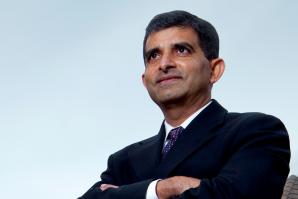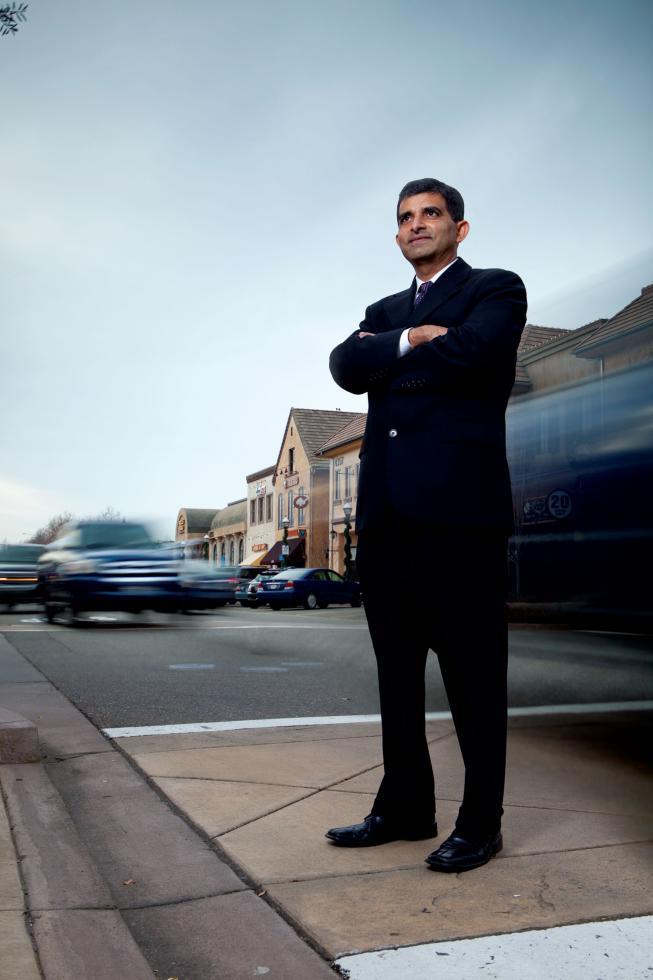Sanjay Varshney, 44, is dean of College Administration at Sacramento State. Last month, in conjunction with the Chartered Financial Analyst Society of Sacramento, he published the seventh issue of the Sacramento Business Review. It offers a look at emerging economic trends and forecasts for 2012 in the Sacramento region, comprised of Sacramento, El Dorado, Placer and Yolo counties.
“For our region, the economy hit rock bottom in 2010. According to my data, the recession was officially over by the beginning of 2011. Economic activity stopped sliding at that time and actually went up in some sectors.”
“There are only two key economic indicators for our region: government and residential real estate. If those two indicators stay either neutral or positive, our region will probably come out of this slow recovery.”
“The government is still broke, both at the state and local levels. That is one major story that is still negative. I recently spoke with Selvi Stanislaus (chief of the Franchise Tax Board), and she was not optimistic about 2012. She expected lower personal income tax revenue but was counting on a bump from corporate income tax. It’s not like the corporations don’t have money, she says they are just finding better ways to shelter their money.”
“Residential real estate has crashed throughout the region, but there are pockets that are beginning to turn. Some pockets, like Serrano (in El Dorado Hills), are still beat up because of the overhang of foreclosures. Folsom also took a U-turn. I never thought Folsom would crash as much as it did. Last year Folsom residential property value was down, like, 10 percent.”
“All it takes is five positive stories to turn around consumer confidence. It is so psychological. It was recently reported national housing sales went up 7 percent. The following day stock prices for several construction companies went up 50 percent. Those stories need to get out to the general public. Once they do, fence- sitters may start spending money again on houses, remodels, cars, appliances and fine dining. But for that to happen, the media has to be supportive.”
“From an employment point of view, the numbers have improved nationally and regionally. Nationally, it’s just over 8 percent. If those numbers hold, Mr. Obama may be electable again. It was up to 12 percent and has come down to 8 percent. ‘Give me four more years, and I’ll show you four more points.’ That’s how election-year political rhetoric often works.”
“Population growth is our region’s biggest economic variable challenge. The greater Sacramento area went from a sleepy town of 500,000 mostly government workers, to a region with 1.8 million people.”
“Unfortunately, this growth was not driven by economic diversity. We had 200,000 people move here from the coast and the Bay Area, (lured by) cheap real estate, not jobs. Some arrived here and continued to commute to the Bay Area. Others simply cashed out, bought a mini mansion, could afford to live like a king and play golf all day.”
“Those 200,000 rich people begin spending money on cars, televisions, attorneys, plumbers, healthcare, etc. That activity draws another 50,000 people to serve those needs. And that mid-level population growth attracts another 50,000 at the bottom of the food chain: housemaids, yard maintenance and minimum-wage retail workers at the big-box outlets. During good times, that food chain works, but when the economy takes a dive, even the rich quit spending money. So now we have 1.8 million people here and only 1.5 million jobs.”
“Our economic base never changed from what it used to be, except now we have a lot more retail outlets, attorneys, grocery stores, restaurants and health care services.”
“Health care is the lone shining star during this population growth spurt. Kaiser, Sutter, Mercy and UCD Med Center have all expanded. Today, we have a very large, state-of-the-art health care core. And we can do something with it to become a mecca for health care services for the Central Valley. So when someone needs major cardiology work they don’t have to go to San Francisco. They can come here.”
“We could become the ‘retirement capital of California.’ How do you think South Florida became an East Coast retirement destination? It was affordable, and you didn’t have to shovel snow during the winter. Sacramento has all the amenities to attract retired seniors, most who have annual incomes of $100,000 or more. We need a consortium of regional leaders to pitch the idea that this is a perfect place for five more Del Webb-like communities.”
Recommended For You

New Angle Needed
Sacramento should try a new approach to economic development
Like many transplants to Sacramento, before moving to the area I had little awareness of the plethora of quality-of-life amenities the region has to offer. As I complete my first decade as a resident, it has dawned on me that this has been the longest stop thus far in my professional career.

The MBA is Not Dead
Demand has ebbed and flowed but remains on high tide
When Laurie Grimsman graduated in June from the Graduate School of Management at UC Davis, she was 51 and a self-proclaimed “age outlier.”



